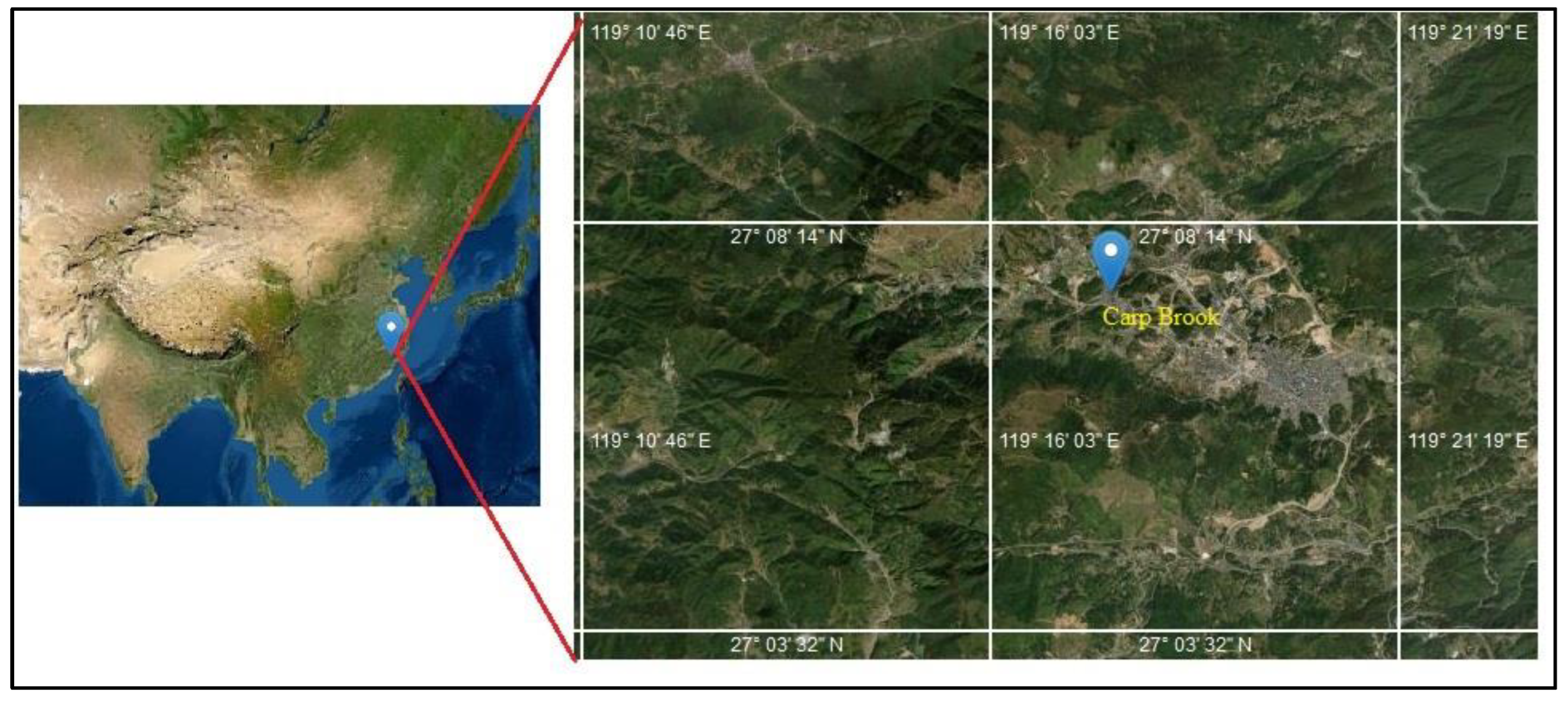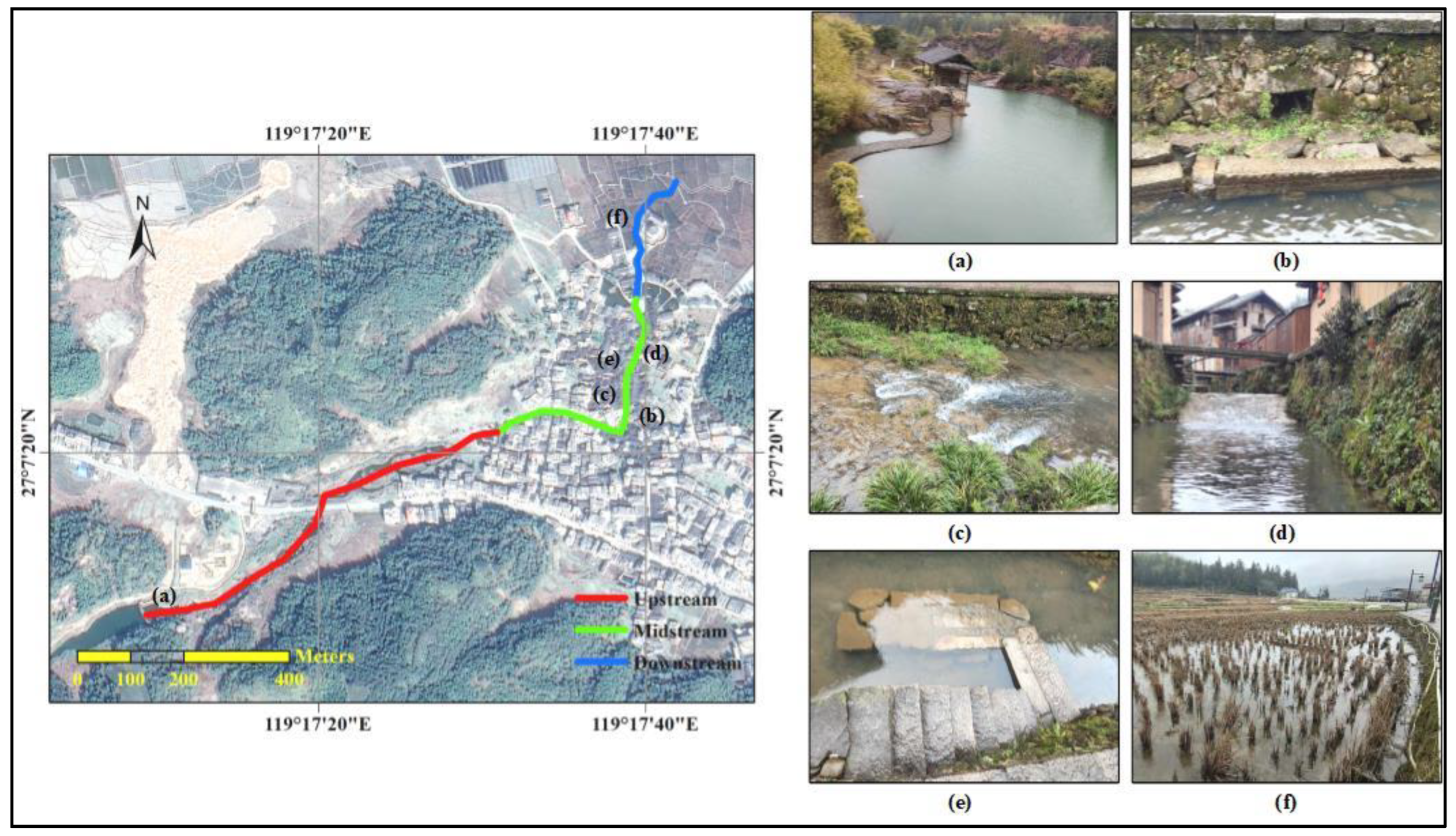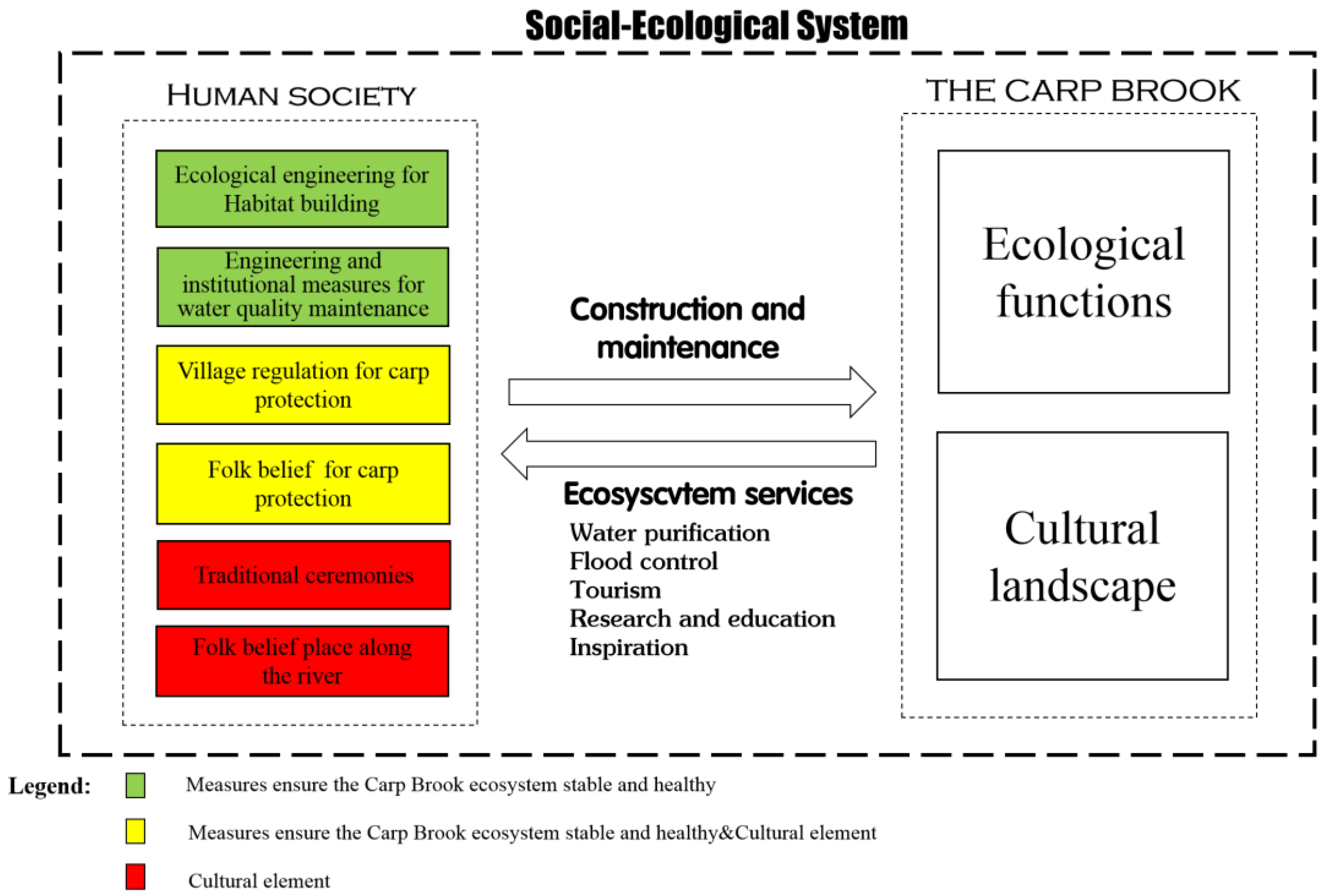Sustainable Ecosystem Services of a Time-Honored Artificial River Ecosystem—Enlightenments from the Carp Brook, in Northern Fujian Province, China
Abstract
1. Introduction
2. Materials and Methods
2.1. Study Area
2.2. Methods and Data Source
2.2.1. Methods
2.2.2. Data Source
2.2.3. Data Analysis
3. Results
3.1. Construction and Maintenance of the Carp Brook
3.1.1. Construction of the Carp Brook
- (1)
- Upstream
- (2)
- Midstream
- (3)
- Downstream
3.1.2. Protection of the Carps
- (1)
- Protect the carps through village regulations.
- (2)
- Protect the carps through folk belief.
- (3)
- Other measures for carp protection.
3.1.3. Maintenance of the Water Quality
3.2. Preservation of Cultural Elements
3.2.1. The Carp Burial and Sacrifice Ceremony
3.2.2. The Folk Belief Place along the Carp Brook
3.3. Ecosystem Services of the Carp Brook
3.3.1. Regulation Services
3.3.2. Cultural Services
- (1)
- Tourism service
- (2)
- Research and education
- (3)
- Inspiration
4. Discussion
4.1. The Interaction between Puyuan Village Society and the Carp Brook Ecosystem
4.2. Some Characteristics of the Carp Brook
4.2.1. The Carp Brook Is a Time-Honored Artificial River Ecosystem
4.2.2. The Carp Culture Are Attractive
4.2.3. The Carp Brook Is a Co-Managed Fish Conservation Zone
5. Conclusions
5.1. Chinese Traditional Views of Nature Is Important for Artificial Ecosystems
5.2. A Choice between Material and Immaterial Services Should Be Made Carefully
5.3. Traditional Folk Customs Have Strong Binding Forces in Ecosystem Protection
Author Contributions
Funding
Institutional Review Board Statement
Informed Consent Statement
Data Availability Statement
Acknowledgments
Conflicts of Interest
References
- Millennium Ecosystem Assessment. Ecosystems and Human Well-Being; Island Press: Washington, DC, USA, 2005. [Google Scholar]
- Stevenson, R.J.; Sabater, S. Understanding effects of global change on river ecosystems: Science to support policy in a changing world. Hydrobiologia 2010, 657, 3–18. [Google Scholar] [CrossRef]
- Yang, H.; Zheng, L.; Wang, Y.; Li, J.; Zhang, B.; Bi, Y. Quantifying the relationship between land use intensity and ecosystem services’ value in the Hanjiang River Basin: A case study of the Hubei Section. Int. J. Environ. Res. Public Health 2022, 19, 10950. [Google Scholar] [CrossRef] [PubMed]
- Thiele, J.; Albert, C.; Hermes, J.; Haaren, C. Assessing and quantifying offered cultural ecosystem services of German river landscapes. Ecosyst. Serv. 2020, 42, 101080. [Google Scholar] [CrossRef]
- Zhang, Z.; Zhang, H.; Feng, J.; Wang, Y.; Liu, K. Evaluation of social values for ecosystem services in urban riverfront space based on the SolVES model: A case study of the Fenghe River, Xi’an, China. Int. J. Environ. Res. Public Health 2021, 18, 2765. [Google Scholar] [CrossRef] [PubMed]
- Karabulut, A.; Egoha, B.N.; Lanzanova, D.; Grizzetti, B.; Bidoglio, G.; Pagliero, L.; Bouraoui, F.; Aloe, A.; Reynaud, A.; Maes, J.; et al. Mapping water provisioning services to support the ecosystem–water–food–energy nexus in the Danube river basin. Ecosyst. Serv. 2016, 17, 278–292. [Google Scholar] [CrossRef]
- Khan, I.; Zhao, M. Water resource management and public preferences for water ecosystem services: A choice experiment approach for inland river basin management. Sci. Total Environ. 2019, 646, 821–831. [Google Scholar] [CrossRef]
- Cheng, P.; Tang, H.; Zhu, S.; Jiang, P.; Wang, J.; Kong, X.; Liu, K. Distance to river basin affects residents’ willingness to pay for ecosystem services: Evidence from the Xijiang river basin in China. Ecol. Indic. 2021, 126, 107691. [Google Scholar] [CrossRef]
- Khan, I.; Zhao, M.; Khan, S.U.; Yao, L.; Ullah, A.; Xu, T. Spatial heterogeneity of preferences for improvements in river basin ecosystem services and its validity for benefit transfer. Ecol. Indic. 2018, 93, 627–637. [Google Scholar] [CrossRef]
- Pham, H.V.; Torresan, S.; Critto, A.; Marcomini, A. Alteration of freshwater ecosystem services under global change—A review focusing on the Po River basin (Italy) and the Red River basin (Vietnam). Sci. Total Environ. 2019, 652, 1347–1365. [Google Scholar] [CrossRef]
- Xia, H.; Kong, W.; Zhou, G.; Sun, O.J. Impacts of landscape patterns on water-related ecosystem services under natural restoration in Liaohe River Reserve, China. Sci. Total Environ. 2021, 792, 148290. [Google Scholar] [CrossRef]
- Polizzi, C.; Simonetto, M.; Barausse, A.; Chaniotou, N.; Känkänen, R.; Keränen, S.; Manzardo, A.; Mustajärvi, K.; Palmeri, L.; Scipioni, A. Is ecosystem restoration worth the effort? The rehabilitation of a Finnish river affects recreational ecosystem services. Ecosyst. Serv. 2015, 14, 158–169. [Google Scholar] [CrossRef]
- Ostrom, E. A general framework for analyzing sustainability of Social-Ecological Systems. Science 2009, 325, 419–422. [Google Scholar] [CrossRef] [PubMed]
- Reyers, B.; Folke, C.; Moore, M.; Biggs, R.; Galaz, V. Social-Ecological Systems insights for navigating the dynamics of the anthropocene. Annu. Rev. Environ. Resour. 2018, 43, 267–289. [Google Scholar] [CrossRef]
- Fischer, J.; Gardner, T.A.; Bennett, E.M.; Balvanera, P.; Biggs, R.; Carpenter, S.; Daw, T.; Folke, C.; RoseHill, R.M.; Hughes, T.P.; et al. Advancing sustainability through mainstreaming a Social–Ecological Systems perspective. Curr. Opin. Environ. Sust. 2015, 14, 144–149. [Google Scholar] [CrossRef]
- Leslie, H.M.; Basurto, X.; Nenadovic, M.; Sievanen, L.; Cavanaugh, K.C.; Cota-Nieto, J.J.; Erisman, B.E.; Finkbeiner, E.; Hinojosa-Arango, G.; Moreno-Báez, M.; et al. Operationalizing the Social-Ecological Systems framework to assess sustainability. Proc. Natl. Acad. Sci. USA 2015, 112, 5979–5984. [Google Scholar] [CrossRef]
- Guerry, A.D.; Polasky, S.; Lubchenco, J.; Chaplin-Kramer, R.; Daily, G.C.; Griffin, R.; Ruckelshaus, M.; Bateman, I.J.; Duraiappah, A.; Elmqvist, T.; et al. Natural capital and ecosystem services informing decisions: From promise to practice. Proc. Natl. Acad. Sci. USA 2015, 112, 7348–7355. [Google Scholar] [CrossRef]
- Zhouning County Local Chronicle Compilation Committee. Zhouning County; China Science and Technology Press: Beijing, China, 1992. (In Chinese) [Google Scholar]
- Zheng, C. Study on the Culture of the Carp Brook; Writers Publishing House: Beijing, China, 2011. (In Chinese) [Google Scholar]
- Bian, L. An outline of folk regulations in Huizhou during Ming and Qing Dynasties. Agric. Hist. China 2004, 4, 97–114. (In Chinese) [Google Scholar]
- Zhang, J. Village governance embodied by village rules and regulations. Peking Univ. Law Rev. 1999, 2, 4–48. (In Chinese) [Google Scholar]
- Sun, T.; Zheng, M. Discussion on the inheritance of regional culture in the practice of new rural reconstruction in Liyuxi Village from the endogenous logic of rural settlement and architecture. Des. Res. 2019, 2, 114–117. (In Chinese) [Google Scholar]
- Zhouning County Local Chronicle Compilation Committee. Zhouning Yearbook (2015); Strait Publishing House: Fuzhou, China, 2015. (In Chinese) [Google Scholar]
- Zhouning County Local Chronicle Compilation Committee. Zhouning Yearbook (2016); Strait Publishing House: Fuzhou, China, 2016. (In Chinese) [Google Scholar]
- Zhouning County Local Chronicle Compilation Committee. Zhouning Yearbook (2017); Strait Publishing House: Fuzhou, China, 2017. (In Chinese) [Google Scholar]
- Zhouning County Local Chronicle Compilation Committee. Zhouning Yearbook (2018); Strait Publishing House: Fuzhou, China, 2018. (In Chinese) [Google Scholar]
- Zhouning County Local Chronicle Compilation Committee. Zhouning Yearbook (2019); Strait Publishing House: Fuzhou, China, 2019. (In Chinese) [Google Scholar]
- Zhouning County Local Chronicle Compilation Committee. Zhouning Yearbook (2020); Strait Publishing House: Fuzhou, China, 2020. (In Chinese) [Google Scholar]
- Zhouning County Local Chronicle Compilation Committee. Zhouning Yearbook (2021); Strait Publishing House: Fuzhou, China, 2021. (In Chinese) [Google Scholar]
- Zhou, X.; Zhang, J.; Zhang, N.; Long, B. Folk belief and its legitimization in China. West. Folk. 2017, 76, 151–165. [Google Scholar]
- Cui, L.Y.; Li, H.; Zhang, W. A study on worship space in ancient villages under the influence of folk beliefs. Chin. Foreign Archit. 2022, 4, 42–47. (In Chinese) [Google Scholar]
- Sun, S.; Xu, L. Pareto improvement and the formation of the Carp Brook. J. Chongqing Univ. Sci. Technol. (Soc. Sci. Ed.) 2010, 10, 82–84. (In Chinese) [Google Scholar]
- Zhang, Y.; Zhang, J. The Carp Brook and Jiulongji Cascade invest 40 million yuan again for the construction of 4A Scenic Spot. Mindong Daily 2009, A02, 1–11. (In Chinese) [Google Scholar]
- South Korea: Restoration of the Cheonggyecheon River in Downtown Seoul. Available online: https://www.ser-rrc.org/project/south-korea-restoration-of-the-cheonggyecheon-river-in-downtown-seoul/ (accessed on 5 February 2023).
- Development of a Species Conservation Action Plan for the Mekong Giant Catfish. Available online: https://r.search.yahoo.com/_ylt=AwrjcJ6.yNljSEIPBCIM34lQ;_ylu=Y29sbwNncTEEcG9zAzUEdnRpZAMEc2VjA3Ny/RV=2/RE=1675245886/RO=10/RU=http%3a%2f%2flibrary.enaca.org%2fgenetics%2fprojects%2fmekong_giant_catfish%2fmgcwg_report_2.pdf/RK=2/RS=HU.UzNf4UoHgHFOD42oLO53yjXA- (accessed on 5 February 2023).
- Dang, X. The function of village regulation for management of water resources in Jinshan area in Ming and Qing Dynasties. Archaeol. Agric. 2010, 6, 10–12. (In Chinese) [Google Scholar]
- Chen, M.; Zheng, B. Village regulations on soil and water conservation in ancient tablet inscriptions in Fujian Province, China. Subtrop. Soil Water Conserv. 2007, 19, 64–67. (In Chinese) [Google Scholar]
- Bian, L. Preliminary study on forest protection inscriptions in Huizhou during Ming and Qing Dynasties. Chin. Hist. 2003, 2, 2109–2115. (In Chinese) [Google Scholar]
- Xu, N. The folk eco-awareness in Guizhou: A case study of the regulation and agreement inscriptions in rural areas. J. Orig. Ecol. Natl. Cult. 2014, 6, 71–75. (In Chinese) [Google Scholar]
- Loury, E.K.; Ainsley, S.M. Identifying indicators to evaluate Community-Managed Freshwater Protected Areas in the Lower Mekong Basin: A review of marine and freshwater examples. Water 2020, 12, 3530. [Google Scholar] [CrossRef]
- Sarakran, P. The participatory characterization based on STEM education in the restricted area for fishing at Tha Song Korn Temple in Khon Kaen Province. J. Phys. Conf. Ser 2019, 1340, 012077. [Google Scholar] [CrossRef]
- Koning, A.A.; Perales, K.M.; Fluet-Chouinard, E.; McIntyre, P.B. A network of grassroots reserves protects tropical river fish diversity. Nature 2020, 588, 631–635. [Google Scholar] [CrossRef]
- Gabrielsson, Å.; Paulsson, M. The actor view of nature and strategic change. Scand. J. Manag. 1996, 12, 317–332. [Google Scholar] [CrossRef]
- Grizzetti, B.; Liquete, C.; Pistocchi, A.; Vigiak, O.; Zulian, G.; Bouraoui, F.; De Roo, A.; Cardoso, A. Relationship between ecological condition and ecosystem services in European rivers, lakes and coastal waters. Sci. Total Environ. 2019, 671, 452–465. [Google Scholar] [CrossRef] [PubMed]
- Braat, L.; de Groot, R. The ecosystem services agenda:bridging the worlds of natural science and economics, conservation and development, and public and private policy. Ecosyst. Serv. 2012, 1, 4–15. [Google Scholar] [CrossRef]
- He, X. On the regional differences of Chinese countryside—From the perspective of village social structure. Open Times 2012, 10, 108–129. (In Chinese) [Google Scholar]




| 2020 | 2021 | 2022 | Grade I Standard for Drinking Water Sources 1 | |
|---|---|---|---|---|
| Chroma | 5.0000 | <5.0000 | 10.0000 | ≤15.0000 |
| Turbidity (NTU 2) | 1.1000 | 0.4100 | 1.5400 | ≤3.0000 |
| Foul smell | none | none | none | none |
| Volatile phenol (mg/L) | <0.0020 | <0.0020 | <0.0020 | ≤0.0020 |
| Anionic synthetic detergent (mg/L) | <0.0500 | <0.0500 | <0.0500 | ≤0.3000 |
| Sulfate (mg/L) | <0.7500 | 2.3320 | 0.8714 | <250.0000 |
| Nitrate (mg/L) | 0.1822 | 1.2940 | <0.1500 | ≤10.0000 |
| Chloride (mg/L) | <0.1500 | 1.0190 | 0.8662 | <250.0000 |
| Fluoride (mg/L) | <0.1000 | <0.1000 | <0.1000 | ≤1.0000 |
| Cyanide (mg/L) | 0.0030 | 0.0090 | 0.0370 | ≤0.0500 |
| Oxygen consumption (mg/L) | 0.4800 | 0.8200 | 0.5800 | ≤3.0000 |
| Ammonia–nitrogen (mg/L) | <0.020 | 0.4830 | <0.020 | ≤0.5000 |
| Total coliform group (MPN/100 mL) | 0.0000 | 2.0000 | 0.0000 | ≤100.0000 |
Disclaimer/Publisher’s Note: The statements, opinions and data contained in all publications are solely those of the individual author(s) and contributor(s) and not of MDPI and/or the editor(s). MDPI and/or the editor(s) disclaim responsibility for any injury to people or property resulting from any ideas, methods, instructions or products referred to in the content. |
© 2023 by the authors. Licensee MDPI, Basel, Switzerland. This article is an open access article distributed under the terms and conditions of the Creative Commons Attribution (CC BY) license (https://creativecommons.org/licenses/by/4.0/).
Share and Cite
Li, Y.; Yi, R.; Liu, L.; Chen, F. Sustainable Ecosystem Services of a Time-Honored Artificial River Ecosystem—Enlightenments from the Carp Brook, in Northern Fujian Province, China. Int. J. Environ. Res. Public Health 2023, 20, 3959. https://doi.org/10.3390/ijerph20053959
Li Y, Yi R, Liu L, Chen F. Sustainable Ecosystem Services of a Time-Honored Artificial River Ecosystem—Enlightenments from the Carp Brook, in Northern Fujian Province, China. International Journal of Environmental Research and Public Health. 2023; 20(5):3959. https://doi.org/10.3390/ijerph20053959
Chicago/Turabian StyleLi, Yuliang, Ran Yi, Lin Liu, and Feng Chen. 2023. "Sustainable Ecosystem Services of a Time-Honored Artificial River Ecosystem—Enlightenments from the Carp Brook, in Northern Fujian Province, China" International Journal of Environmental Research and Public Health 20, no. 5: 3959. https://doi.org/10.3390/ijerph20053959
APA StyleLi, Y., Yi, R., Liu, L., & Chen, F. (2023). Sustainable Ecosystem Services of a Time-Honored Artificial River Ecosystem—Enlightenments from the Carp Brook, in Northern Fujian Province, China. International Journal of Environmental Research and Public Health, 20(5), 3959. https://doi.org/10.3390/ijerph20053959






